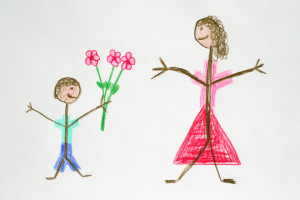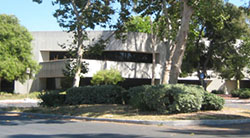
How do you know if you have a gifted child? There are signs that can tell you if you do have a gifted child. There may be signs of a higher order of intelligence or unusually mature behavior that may or may not be easily observed.
However, there is another sign, often overlooked but just as valid as a clue to giftedness: drawing.
Research into giftedness has revealed that there are certain aspects of drawing at a young age that can point to potential genius. There are details in drawings made by gifted children that don’t usually appear in the drawings of non-gifted children.
One study revealed that 47% of gifted children who were observed showed exceptional detail or perspective in their drawings, exemplified certain features commonly drawn by gifted children.
What can a stick figure tell you?
For example, young children learn to draw stick figures to represent human beings. That is quite common. However, gifted children sometimes draw a person’s head from the side rather than the front. Gifted children use many details (called “exceptional items”) like eyelashes and makeup that reveal a higher order of observation.
These children, aged seven to nine, use many of the 30 detail items that have been identified as pointing toward giftedness.
A gifted child will draw not only a face but freckles, braces or a goatee. The child may draw not only a nose but add mucus. In drawing an arm, the child may add hair. A hand might show a ring or gloves.
Even that stick figure can reveal giftedness. The hands might be drawn behind the figure’s back or placed in “pockets.” Any drawing that shows an unusual perspective just might reveal a higher order of thinking.
A drawn figure may have added detail like a tie or jewelry. The figure may be wearing a badge. You can look for these added details for clues to your child being gifted and talented.
These are examples of what researchers call HFD (Human Figure Drawing). This type of analysis is becoming more prevalent in the identification of giftedness.
Another label researchers have placed on gifted artists is “precocious realist.” They see and can interpret more enhanced detail in their surroundings vs. non-gifted individuals who merely “represent” what they see.
What can the big dog tell you?
Children sometimes draw a dog or a cat. Pets are a normal subject of drawings. A child might draw the animal larger than its owner. This is the child’s perspective on the importance of the animal in his or her life at the moment and is a normal reaction. A gifted child might add fur, a collar, or a tongue hanging out, and add something else in the dog’s life – a bone, another dog, a dog house.
To look for giftedness, look beyond the normal – look for the level of detail and look for an unusual point of view. Giftedness goes beyond intelligence testing. High IQ is a recognized parameter in identifying gifted children. But it goes beyond that. Creativity is another guideline, and it is not as easy to measure.
Your child is unique
Whatever your child draws, he or she is unique. The drawing comes from an individual perspective and thought process. It is an example of self-expression, originality and creativity. These are signs of giftedness just as important as IQ testing. They can be indicators of rare talent in any of a myriad of different fields – in science, art, music, engineering, or even behavioral areas like leadership.
For example, some children use art as a tool to study some topic of interest, like drawing insects or animals to study biology. They might be on their way to a career in science.
There is no right or wrong answer in the expression of art like there is in standardized IQ testing. These tests indicate levels of intelligence but not creativity or originality. Leadership often involves coming up with unique solutions to problems by looking at things differently. Drawings from young people can foreshadow that skill.
Your child may be artistically gifted if he or she exhibits these characteristics:
- Show imagination and expression
- Exhibit high sensitivity to color, space, rhythm or movement
- Demonstrate connection between thinking, feeling and perceiving
- Show uniqueness of ideas
- Expresses a directness that comes from personal experience
- Draw well by the age of two
- Have a good sense of design
- Demonstrate a high degree of frequency with their preferred art medium
Beyond the drawings
Drawings aren’t the only way to measure creativity. Gifted children often have novel ideas and think “outside the box.” They are flexible in their thinking. They often give unusual or unexpected answers on IQ tests. These answers aren’t “right” or “wrong” on the tests and aren’t scored correctly because they don’t match what is in the scoring manual.
Researchers also point out that drawing analysis is valid only for younger children. When they reach school age, there is a negative influence that stems from the standardization imposed by classroom norms with uniform practices and expectations. Individualization must yield to group pacing and progress.
Parents have noted that their young children exhibited very creative drawings in their early years. After being in school for some time, their drawings then became simpler and more similar to those of their classmates.
So beyond the early years of drawing, there is a need to look for other examples of creative thinking and expression. One thing to consider is that some gifted children will not do well in testing because of anxiety. They are driven to perfection and may have a case of nerves. This was not the case when they were asked to make a drawing when they were more relaxed and familiar with the subjects they were drawing. So in some sense, the drawings might be more accurate in determining potential.
So what other traits, beyond drawing, might indicate creativeness? Studies of “eminent individuals” have identified several characteristics including the following.
- Varied interests: Creative individuals have an array of interests and can make connections between them to a greater extent than their peers.
- Curiosity: These individuals have a thirst for information and are open to vague or complex input. They are eager to explore and investigate the unknown.
- Connecting the dots: Creative people can make connections between disparate data in their environment to further develop their own ideas or work. They see how things relate to each other better than their peers.
- Flexibility: Creative persons are not locked into one line of thought but are capable of playing with ideas, changing their minds, and trying new methods or approaches.
- Independence: Creative people like to work alone with their ideas, perhaps because they see things differently from others. They tend to be more introverted, maybe because their energy is self-driven and does not require the influence of others.
Going back to the early drawings, you can look for some of these traits in addition to those “exceptional items” mentioned earlier. Do your creative children like to work alone? Are they flexible enough to see things in more than one way? Can they interpret vague ideas? Can they represent a complex subject in some simple way? Do they appear to be visually gifted?
The more attention you pay to those simple drawings, the better idea you will get as to the potential giftedness of your child. That stick figure might be telling you something more than you realize.




